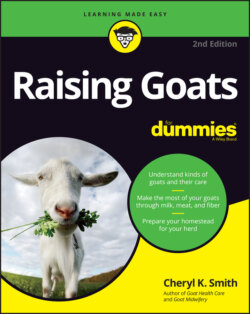Читать книгу Raising Goats For Dummies - Cheryl K. Smith - Страница 51
Using ruminations as a health indicator
ОглавлениеBecause rumination is an essential part of how goats digest food (see the section “The digestive system”), you can use cud-chewing as an indicator of goat health. A ruminating goat is eating and generating heat and energy. You can determine whether a goat is ruminating in two ways: by looking for cud-chewing and by listening to the goat’s body.
A goat’s rumen is located on the left side of the abdomen. You can watch this area or feel the side of the abdomen for movement.
The best way to determine whether a goat is ruminating and the strength and frequency of rumination is to listen. Often, ruminations are loud enough that you can hear them by just sitting next to the goat. If you can’t hear them, put your head up to the left side of your goat’s abdomen. If you still have trouble hearing ruminations, use a stethoscope. You can purchase an inexpensive stethoscope from a livestock supply catalog.
Healthy ruminations are loud, sound kind of like a growling stomach, and occur about two or three times a minute. If they are weak or infrequent, give your goat some roughage and probiotics (“good” microbes given orally that protect against disease) to stimulate the rumen and to add to the rumen bacteria.
Look around your herd to see whether each goat is chewing her cud. I’ve found that a good time for this is the early afternoon, when the goats are resting before their last go at the pasture for the day. Usually at least two-thirds of them will be ruminating at the same time. Take a closer look at any goats that aren’t chewing cud. If they don’t look well in some other way (see the section, “Signs of a Healthy Goat”), go up to them and listen for rumination sounds.
